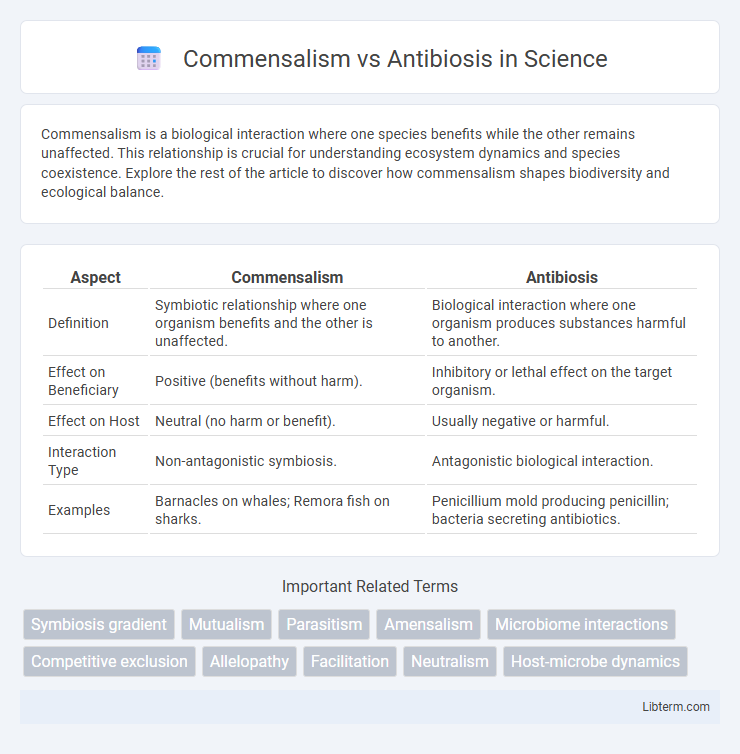Commensalism is a biological interaction where one species benefits while the other remains unaffected. This relationship is crucial for understanding ecosystem dynamics and species coexistence. Explore the rest of the article to discover how commensalism shapes biodiversity and ecological balance.
Table of Comparison
| Aspect | Commensalism | Antibiosis |
|---|---|---|
| Definition | Symbiotic relationship where one organism benefits and the other is unaffected. | Biological interaction where one organism produces substances harmful to another. |
| Effect on Beneficiary | Positive (benefits without harm). | Inhibitory or lethal effect on the target organism. |
| Effect on Host | Neutral (no harm or benefit). | Usually negative or harmful. |
| Interaction Type | Non-antagonistic symbiosis. | Antagonistic biological interaction. |
| Examples | Barnacles on whales; Remora fish on sharks. | Penicillium mold producing penicillin; bacteria secreting antibiotics. |
Understanding Commensalism and Antibiosis
Commensalism describes a biological interaction where one organism benefits while the other remains unaffected, exemplified by epiphytic plants growing on trees without harming them. Antibiosis involves one organism producing substances that inhibit or destroy another, such as antibiotic-producing bacteria suppressing competitor microbes. Understanding these interactions highlights their ecological roles, with commensalism contributing to biodiversity and antibiosis influencing microbial population dynamics and disease control.
Defining Commensalism in Nature
Commensalism in nature describes a biological interaction where one species benefits without affecting the other, such as epiphytic plants growing on trees to access sunlight without harming the host. This relationship contrasts with antibiosis, where one organism produces substances detrimental to another, often inhibiting growth or survival. Understanding commensalism highlights ecological balance and species coexistence, emphasizing non-harmful association in ecosystems.
Characteristics of Antibiosis Relationships
Antibiosis is characterized by one organism producing biochemical substances that inhibit or destroy the growth of another organism, often seen in interactions between bacteria and fungi. This relationship typically benefits the inhibiting organism by reducing competition for resources, while the target organism is harmed or suppressed. Unlike commensalism, antibiosis involves a clear antagonistic effect rather than a neutral or harmless association.
Key Differences Between Commensalism and Antibiosis
Commensalism involves a biological interaction where one organism benefits without affecting the other, exemplified by barnacles on whales. In contrast, antibiosis is a relationship where one organism produces substances harmful to another, such as antibiotic-producing bacteria inhibiting pathogens. Key differences include the neutrality of the host in commensalism versus the detrimental impact on one organism in antibiosis.
Ecological Roles of Commensalism
Commensalism plays a crucial ecological role by enhancing biodiversity through relationships where one species benefits without harming or benefiting the other, such as epiphytic orchids growing on trees. These interactions contribute to habitat complexity and resource distribution, supporting ecosystem stability and resilience. Unlike antibiosis, which involves harmful effects like antibiotic production to inhibit competitors, commensalism maintains ecological balance by fostering coexistence and mutual habitat utilization.
Impact of Antibiosis on Ecosystems
Antibiosis significantly influences ecosystems by regulating microbial populations and maintaining ecological balance through the inhibition or destruction of competing organisms. This interaction promotes biodiversity by preventing the dominance of any single species and supports nutrient cycling by affecting microbial decomposers in soil and aquatic environments. The presence of antibiotic-producing microbes also impacts plant health and productivity by suppressing soilborne pathogens, thus contributing to ecosystem stability.
Real-World Examples of Commensalism
Commensalism is exemplified by barnacles attaching to whales, benefiting from transportation and access to food without harming the host, contrasting antibiosis where antibiotics secreted by fungi inhibit bacterial growth. Another well-known case involves epiphytic orchids growing on trees to access sunlight without extracting nutrients, differing from antibiosis interactions where one organism restrains another's growth through biochemical means. These examples highlight commensalistic relationships characterized by one species gaining advantage without negatively affecting the other, unlike the antagonistic nature of antibiosis in microbial ecosystems.
Antibiosis in Microbial Interactions
Antibiosis in microbial interactions refers to a biological relationship where one microorganism produces substances that inhibit or destroy the growth of another microorganism, often antibiotics or bacteriocins. This antagonistic interaction plays a crucial role in controlling microbial populations and maintaining ecological balance within diverse environments such as soil or the human microbiome. Unlike commensalism, where one organism benefits without affecting the other, antibiosis directly impacts the survival and proliferation of competing microbial species.
Evolutionary Significance of Commensalism and Antibiosis
Commensalism promotes species coexistence by allowing one organism to benefit without harming the other, driving evolutionary adaptations that enhance niche differentiation and resource partitioning. Antibiosis results in competitive exclusion through the production of antimicrobial substances, which shapes microbial community structure and fosters evolutionary arms races between producers and sensitive species. The evolutionary significance of these interactions lies in their roles in maintaining biodiversity, influencing population dynamics, and guiding species evolution within ecosystems.
Commensalism vs Antibiosis: A Comparative Overview
Commensalism involves a symbiotic relationship where one organism benefits while the other remains unaffected, exemplified by bacteria living on human skin without harm. Antibiosis represents an antagonistic interaction where one organism produces substances that inhibit or kill another, such as antibiotic-producing microbes suppressing competitors. Comparing these interactions highlights commensalism's neutrality versus antibiosis's competitive inhibition in microbial ecosystems.
Commensalism Infographic

 libterm.com
libterm.com